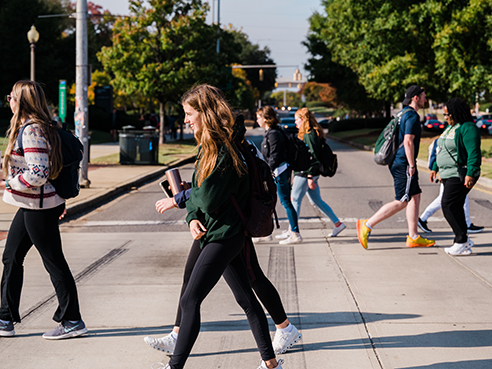 In 2020, the Insurance Institute for Highway Safety reported that pedestrian fatalities have risen 59% since 2009 with more than 6,500 pedestrian deaths occurring in 2020 alone.
In 2020, the Insurance Institute for Highway Safety reported that pedestrian fatalities have risen 59% since 2009 with more than 6,500 pedestrian deaths occurring in 2020 alone.
“Because UAB is located in Birmingham’s city center, pedestrian safety is of the utmost importance,” said Marvin Hart, sergeant in the UAB Police and Public Safety Department.
Remember these four tips for staying safe as a pedestrian on campus.
1. Don’t jaywalk — crosswalk instead.
In 2020, more than 54,700 pedestrians were injured by vehicles, according to the National Highway Traffic Safety Administration.
David Schwebel, Ph.D., University Professor in the Department of Psychology and director of the UAB Youth Safety Lab, studies pedestrian behavior and explains that walking is just like driving — laws need to be followed for safety reasons.
“Drivers wouldn’t run a red light or dart their vehicles into an intersection when traffic is coming the other way, so why do some pedestrians feel that is OK?” he asked. “When you jaywalk, you are openly and blatantly breaking the law, which you don’t usually do when driving near intersections, but many pedestrians feel it’s justified.”
Plus, in Birmingham, it’s against city ordinance to cross a street anywhere but a crosswalk; jaywalkers can receive a fine and have to pay court costs to contest it.
2. Keep your head up and your phone down.
According to the Consumer Product Safety Commission, nearly 5,000 people were injured when walking and using a cellphone or electronic device in 2013. Distracting yourself while walking can cause trips and falls for the distracted walker and other pedestrians.
Schwebel said his research has shown that using the phone while walking significantly increases your risk of injury.
“If you’re on the phone, text-messaging, browsing the Internet or listening to music, our research shows that activity greatly increases your risk of being hit by a car,” Schwebel said. “Walking actually involves a fair amount of complex thinking. Our brain has to work hard to make sure we walk safely, especially near traffic. Our brain also has to work hard to text-message. It has to think about what you’re reading, how to respond, how to type. Brains can handle only so much. If we give the brain too much to do, mistakes can happen.”
3. Stick to the sidewalk.
UAB is an urban campus, and sidewalks are plentiful. If for some reason a sidewalk isn’t available, AAA recommends walking on the far side of the road facing traffic to help increase your visibility to drivers.
“During dusk or dawn and times of reduced visibility, it becomes more difficult for drivers to detect pedestrians,” Hart said. “Using sidewalks, wearing reflective, light-colored clothing and traveling free of distractions are imperative.”
4. Be visible.
Pedestrians should always assume that drivers are not paying attention, and ensuring drivers see you is one of the most important factors in staying safe. At nighttime, pedestrians should wear reflective or light-colored clothing to alert drivers and stay in well-lit areas. If possible, AAA recommends making eye contact with approaching or stopped drivers to ensure they are aware of your presence.
“Our central goal is to safeguard lives and serve the UAB community,” Hart said. “Together, through attentiveness, awareness and cooperation, we can continue to improve the safety of pedestrians and drivers on the UAB campus.”